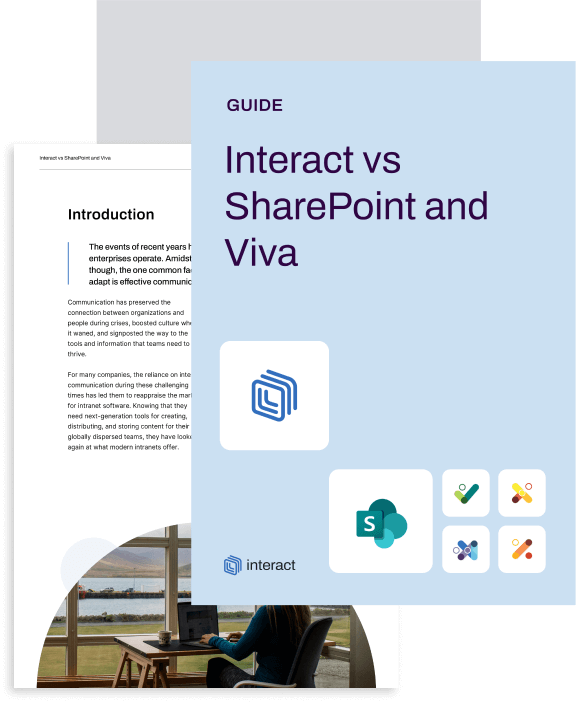In the early stages of an intranet build, the chances of someone in your organization pushing SharePoint forward as a viable option is high. However, when you’re carrying out research for possible intranet providers, it’s clear that SharePoint is not always the wisest option. This article breaks down what it’s important to look beyond a SharePoint intranet.
For communicators especially, building a SharePoint intranet risks wasting money, time, and effort on a platform that ultimately wasn’t built for multichannel communications.
Plus, the market for modern intranet software is now so advanced that SharePoint alternatives can be a cost-effective and easily implemented choice.
Interact vs. SharePoint: discover the best intranet solution for your organization
To prepare for the SharePoint argument, it’s a good idea to know exactly what an independent intranet such as Interact can do – and what SharePoint can’t.
We’ll explore the reasons why using SharePoint as your company’s intranet could be a very expensive, time-consuming mistake.
The history of SharePoint and SharePoint intranets
SharePoint was launched in 2001 as a document management system (DMS). With its inclusion in the Office 365 suite (now M365), it has experienced more and more interest for its role as an intranet platform.
While the cloud-based applications of M365 carry a lot of value for the modern workplace, SharePoint often does not work optimally as an alternative to a dedicated out-of-the-box intranet focused on internal communications.
In truth, SharePoint is only one aspect of the complex digital workplace that an intranet embodies. If we pull apart the most important facets of an intranet, we see that SharePoint only fulfils a small part of a very big picture.
We estimate that 81% of every new intranet inquiry that comes to Interact is due to an existing failing SharePoint intranet.
Why are SharePoint drop off rates high enough that communicators seek out SharePoint alternatives?

In an intranet build, SharePoint is often prioritized by internal stakeholders keen to exploit the M365 package. This seems to make sense, but it’s often not the best solution.
The most popular misconceptions for using SharePoint as an intranet:
- “SharePoint is free” – SharePoint is part of the Microsoft 365 package, so not free. Moreover, the cost of building an intranet on SharePoint can be high and involve third-party developers for all but the very biggest enterprises.
- “Everyone already has access to it” – Desk-based employees may have access, but those who work on the frontline, on the shop-floor, in depots, warehouses, or on the road will have limited access to a computer, making their access to a SharePoint intranet potentially problematic. Many employees also don’t have M365 licenses, meaning restricted access to comms and ability to engage with the organization.
- “SharePoint is an intranet” – Despite the argument that SharePoint is an intranet, it isn’t. Its fundamental role is to store files not to connect dispersed workplaces through multichannel communications.
Here are 14 reasons why your SharePoint intranet isn’t really an intranet
1. Customization of a SharePoint intranet can be difficult
Its origins and role as a DMS means SharePoint was never designed to be a customizable intranet platform. If you do hope to adjust it to your specifications, it may cost a considerable amount of money. Sourcing this service is hard—IT specialist SharePoint developers are in-demand, and, as a result, are notoriously expensive.
This scarcity means that timescales can often overrun. One option is to purchase bolt-on intranet services which lay on top of SharePoint and add additional costs there too.
Then there may also be the cost of maintaining, creating bug fixes, adding new features, and further scaling for years to come.
2. Democratization of intranet management
Because SharePoint site creation and infrastructure are complex, management of this type of ‘intranet’ may be controlled by IT administrators rather than intranet authors or communicators.
For a team of intranet managers or internal communicators, this means the continual development and adaptation of their intranet to user needs can be stymied by resources in a different department.
Interact vs. SharePoint: discover the best intranet solution for your organization
3. SharePoint can become unwieldy
SharePoint is based on the principle of ‘sites’. This infrastructure means that information can often be siloed into hundreds of different sites with many different unique permission settings. SharePoint has tried to remedy this with Hub Sites which aggregate news and content from all its sites. However, these may still have limitations for your organization or technical skills.

4. Difficult to budget for
SharePoint intranet builds can be difficult to cost and even more challenging to create on a rapid timeline. With the amount of time, resources, and specialist SharePoint developers needed, the cost and time to value of successfully using the system may veer off track.
5. Reduced personalization?
To boost engagement, one feature of a modern intranet should be advanced personalization options; used to surface relevant news and updates to employees and give them options to tailor their own content. With SharePoint, however, this may be limited.
If you want staff to see updates and communications relevant to their interests and roles, SharePoint alternatives may be a better fit.
6. Limited navigation
Despite SharePoint’s best efforts to join sites together, navigation may be more limited than in some independent alternatives designed solely to be a user-friendly intranet platform. Making information easy to find should be what your intranet is purpose-built for.
7. Restricted content management
Historically, managing content has meant working in the backend of SharePoint instead of using lists and libraries like a custom-made intranet. Although things have improved in recent years with the advent of Microsoft Viva, for communicators who need to add, update, lift, and shift content easily, the simplicity of a modern intranet with an AI-powered block editor is a big draw.

8. Administrative burden
The governance of permissions, controls, targeting, and, personalization can mean an increased burden on technical support and administration. If an in-house team isn’t able to take it on, it could mean hiring outside help at great expense.
9. Processes may be slower
Because of the burden on technical resources, processes become bottle-necked and delays in actioning are common. In fact, Interact’s research of previous SharePoint customers reveals that requests for alterations were nine a month, each of which took 3.5 days to resolve.
When it comes to using a modern intranet, optimizing tech is usually a faster process, with the vendor typically providing efficient technical support. However, some alterations to the intranet may be far more straightforward than a SharePoint-based solution and can therefore be completed by your own internal stakeholders involved in intranet management, administration and governance, without the need for IT or vendor support.
10. Features are forced down
Your SharePoint intranet is at the behest of Microsoft, meaning any decisions on changes or directions it takes in the future are made in Silicon Valley, not in your organization.
11. Will you get the design you want?
Microsoft introduced Community Sites in 2017 as a way of allowing the user to create a visually appealing frontend to a site using web parts and a building block approach. However, the design functionality offered by Microsoft’s site templates may not give you everything you desire in a way that reflects the unique culture and brand of your organization.
Interact vs. SharePoint: discover the best intranet solution for your organization
12. Heavy technical support needed?
Perhaps you can hold the different options in your head, but if you’re a little confused by the vast number of Hub Sites, Communication Sites, Team Sites, Parent Sites, Community Sites, and more, a user-centric intranet designed for communicators and content authors may be a better alternative.

13. Control over priority news
For important news that needs to be kept visible to the workforce, it’s essential for communicators to have easy methods of homepage management. SharePoint news can be complex to upload, manage and prioritize so that key content remains present and does not get pushed off the page by newer stories.
14. Training is extensive
Training users on a SharePoint intranet can usually take much longer than custom-made intranet solutions.
Should I implement a SharePoint intranet?
Building an intranet on SharePoint may expose you to numerous risks. Not only could it take a huge amount of time and effort to build and manage, but it may also cost a significant amount of money, particularly compared to an out-of-the-box intranet product like Interact.
Its position as an IT-focused platform means that user-centricity and simple UX principles can be hard to replicate, potentially leading to a bad user experience and causing a slide in user adoption.

SharePoint has value in a workplace and Interact makes sure workers have access to its uses. In fact, our software can be quickly and easily configured to work alongside a number of M365 applications, creating an intuitive and seamless digital workplace experience.
Users can have full access to M365 without ever having to leave the intranet, and our search functionality includes indexed SharePoint files. Important documents like HR files can be accessed from SharePoint but have the Interact benefits of Mandatory Read, commenting and feedback.
While it’s not impossible to use SharePoint as an intranet, it can involve time and resources that organizations do not have or wish to spend. Interact provides a fast, smart option while still allowing you to enjoy SharePoint’s benefits.


